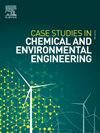菠萝皮废弃物纳米氧化锌-碳复合材料的合成、表征及其对亚甲基蓝的吸附及光催化活性
Q1 Environmental Science
Case Studies in Chemical and Environmental Engineering
Pub Date : 2025-01-23
DOI:10.1016/j.cscee.2025.101113
引用次数: 0
摘要
合成染料废水由于其毒性造成了严重的环境问题。本研究以菠萝皮为原料,经氧化锌纳米粒子修饰制备了一种生物吸附剂,即ZnONPs/PPWB,用于去除水溶液中的阳离子染料,特别是亚甲基蓝。以菠萝皮废弃物为还原剂和碳源,通过简单绿色合成氧化锌纳米颗粒制备ZnONPs/PPWB复合生物吸附剂,并在400℃低温下煅烧2 h。利用brunauer - emet - teller (BET)表面积、扫描电镜(SEM)、x射线衍射(XRD)和傅里叶变换红外(FTIR)对制备的复合生物吸附剂的性能进行了表征。考察了pH、MB初始浓度、接触时间、生物吸附剂用量以及光催化活性等关键因素。ZnONPs/PPWB吸附MB符合Freundlich模型(R2 = 0.9842)和Elovich动力学模型(X2 = 0.7390)。在以下条件下,ZnONPs/PPWB复合生物吸附剂的最大吸附量(qmax = 65.43 mg/g)比非复合生物吸附剂(PPWB) (qmax = 35.21 mg/g)高1.85倍;吸附剂剂量为10 mg/30 mL, pH为7,初始MB浓度为20 mg/L。此外,在太阳辐照下,复合ZnONPs/PPWB生物吸附剂对MB的去除效果优于未辐照的ZnONPs/PPWB。综上所述,本研究突出了将农业废弃物转化为ZnONPs/PPWB复合生物吸附剂去除废水中阳离子染料的有效性和可行性。本文章由计算机程序翻译,如有差异,请以英文原文为准。
Synthesis and characterization of zinc oxide nanoparticles-carbon composite derived from pineapple peel wastes for adsorption of methylene blue from solution and photocatalytic activity
Synthetic dye effluent poses substantial environmental issues due to its toxicity. In this work, a biosorbent derived from pineapple peels and modified with zinc oxide nanoparticles namely ZnONPs/PPWB, was prepared for the removal of cationic dyes, specifically methylene blue (MB), from aqueous solution. The ZnONPs/PPWB composite biosorbent was prepared through a facile green synthesis of zinc oxide nanoparticles utilizing pineapple peel wastes as the source of reducing agent and carbon sources, followed by a calcination at a low temperature of 400 °C for 2 h. The properties of the prepared composite biosorbent were characterized using Brunauer-Emmet-Teller (BET) surface area, scanning electron microscopy (SEM), X-ray diffraction (XRD) and fourier transform infra-red (FTIR) analyses. Several key factors, including pH, initial MB concentration, contact time, and biosorbent dosage as well as photocatalytic activity were investigated. The adsorption of MB on ZnONPs/PPWB is well described by the Freundlich model (R2 = 0.9842) and follows the Elovich kinetic model (X2 = 0.7390). The calculated maximum adsorption capacity of the ZnONPs/PPWB composite biosorbent (qmax = 65.43 mg/g) was 1.85 folds higher compared to the non-composite biosorbent (PPWB) (qmax = 35.21 mg/g) under the following conditions; adsorbent dose of 10 mg/30 mL, pH 7, and initial MB concentration of 20 mg/L. In addition, under solar irradiation, the composite ZnONPs/PPWB biosorbent exhibited the greater MB removal efficiency than non-irradiated ZnONPs/PPWB. In summary, this work highlights the effectiveness and feasibility of transforming agricultural wastes into ZnONPs/PPWB composite biosorbent for the removal of cationic dyes from wastewater.
求助全文
通过发布文献求助,成功后即可免费获取论文全文。
去求助
来源期刊

Case Studies in Chemical and Environmental Engineering
Engineering-Engineering (miscellaneous)
CiteScore
9.20
自引率
0.00%
发文量
103
审稿时长
40 days
 求助内容:
求助内容: 应助结果提醒方式:
应助结果提醒方式:


